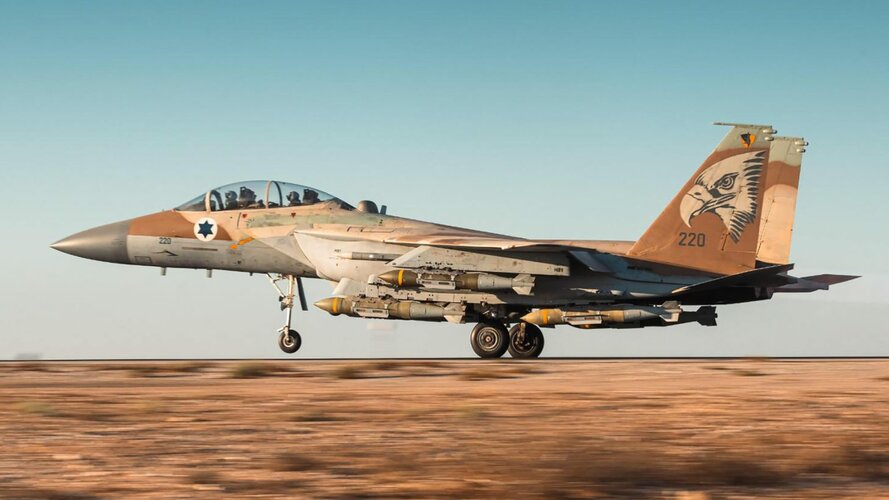I've thought this thread is on a wrong section of the forum on first glance.I don't understand why this thread is not about Japanese planes
You are using an out of date browser. It may not display this or other websites correctly.
You should upgrade or use an alternative browser.
You should upgrade or use an alternative browser.
The Great Turkey Shoot over Jordan: the story of the Iranian Drone and Missile attack against Israel and how it was defeated
- Thread starter TomcatViP
- Start date
Iron Dome can't even handle TBMs, let alone proper theatre ballistic missiles Iran used on True Promise 2. It's outside the equation this time around.Does anyone know what interceptors were used?
The purple blossoms look exoatmospheric, so... Arrow?
Showery things look endoatmospheric, so David's Sling?
Some videos seem to show very low altitude explosions - ?Iron Dome, or more David's Sling?
Iron Dome is sure as heck not optimized for MRBM fire, but given the low interceptor cost, you might as well expend a few against incoming, especially against missiles ignored by the higher tiers of the air defense system?
It seems that the Israelis would have had to prioritize their ABMs for this massed strike - there's not necessarily a point in intercepting missiles bound for hardened aircraft shelters and runways that are relatively easy to fix, or urban areas benefitting from warning and adequate shelter, and Israel does not have that many Arrow missiles. There would seem to be incentive to "pick your battles" so to speak, and conserve firepower for the Big One.
So it's either David' Sling (Stunner) or Arrow, linked to Green Pine EW radar. They've unfortunately mothballed all of their Patriots a few months ago after the first Operation True Promise, so I think they might regret that decision. Though most sources I find say that those Israeli Patriots are 104D variants that can't use GEM-T, so maybe not so much. This also lines up with various sources claiming that Patriot wasn't really effective. Though there are other sources that say Israel did indeed use GEM-T missiles while they operated Patriot batteries, (which must mean they've upgrade their systems to E standard at some point?) so there definitely are conflicting information around.
Apart from Israel's own BMD assets, USN DDGs shot down a few missiles with around a dozen SM-3s. I think it checks out, but considering how many SM-3s a single DDG carries around, that probably means a sizeable portion of SM-3s deployed on 5th fleet boats have been used this week.
- Joined
- 4 July 2010
- Messages
- 2,512
- Reaction score
- 3,088
Video from Jordan, showing intercepts much further up then ballistic arc than seen in the footage over Israel itself.
View: https://x.com/mhmiranusa/status/1841573187374481831?t=LCl5Rc18Hm5xx3weMAiw0A&s=19
View: https://x.com/mhmiranusa/status/1841573187374481831?t=LCl5Rc18Hm5xx3weMAiw0A&s=19
HyFonic
ACCESS: Restricted
- Joined
- 5 March 2020
- Messages
- 43
- Reaction score
- 135
This thread has a good breakdown of the known types that were used, Iranian state media put out some footage of the launches. Impossible to say if this includes all types that were used, but it's probably close. Take the capabilities of all systems with a grain of salt, but info is scarce enough that you don't have really much choice.What is the designation for the Iranian ballistic missiles? What is the range? What warhead type?
I'll summarize to save the clicks: Emad, Ghadr-F/H (with MARV), Kheybar-Shekan 2, and an unknown missile that may have been the hypersonic Fattah-1, or a regular Kheybar-Shekan. Hard to distinguish the two as they use a common booster.
View: https://x.com/AmirIGM/status/1841249748574970047
Scott Kenny
ACCESS: USAP
- Joined
- 15 May 2023
- Messages
- 11,448
- Reaction score
- 13,963
Again, Respondeat Superior.Nah, they just didn't want to escalate things TOO FAR. Do not forget, that Iran was a target of terror strikes by Iraq in 1980s, and understood such things rather well.
The Iranian government is responsible for the actions of those they employ. Houthis, Hamas, Hezbollah, etc ad nauseam are all employees of the Iranian government.
Dilandu
I'm dissatisfied, which means, I exist.
Which one? Iran have two parallel government; religious one and secular one. The secular one seems to not be even informed until right before the attack.The Iranian government is responsible for the actions of those they employ. Houthis, Hamas, Hezbollah, etc ad nauseam are all employees of the Iranian government.
Dilandu
I'm dissatisfied, which means, I exist.
Hm. The first post-strike satellite photos of Nevatim airbase. Looks like two hits:

 * First hit - hangar from theright row. One building destroyed, the one near damaged.
* First hit - hangar from theright row. One building destroyed, the one near damaged.
* Second hit - white crater in the runaway just below the center of image (upper one)
Looks like Iranian missiles are fairly accurate, and the two that penetrated defenses hit where they supposed to.
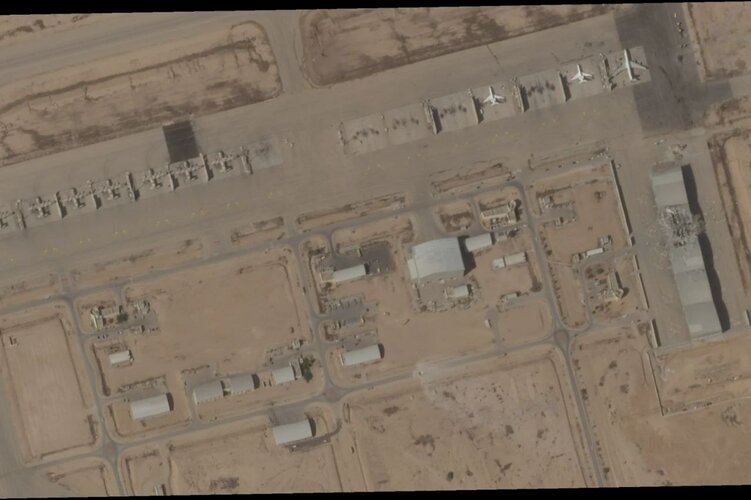
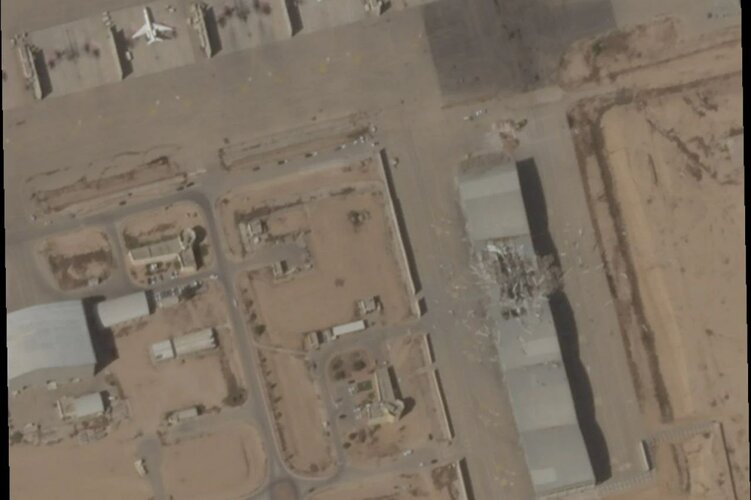 * First hit - hangar from theright row. One building destroyed, the one near damaged.
* First hit - hangar from theright row. One building destroyed, the one near damaged.* Second hit - white crater in the runaway just below the center of image (upper one)
Looks like Iranian missiles are fairly accurate, and the two that penetrated defenses hit where they supposed to.
Scott Kenny
ACCESS: USAP
- Joined
- 15 May 2023
- Messages
- 11,448
- Reaction score
- 13,963
The religious one runs the country.Which one? Iran have two parallel government; religious one and secular one. The secular one seems to not be even informed until right before the attack.
Dilandu
I'm dissatisfied, which means, I exist.
Well, the recent events indicates, that their grip may be seriously slipping. Do not forget, that their head honcho is 85 years old and quite ill. He hardly looks as someone who is willing - and capable - to protect his power. And their new president seems to be quite interested in taking as much power as he could from religious authorities.The religious one runs the country.
Scott Kenny
ACCESS: USAP
- Joined
- 15 May 2023
- Messages
- 11,448
- Reaction score
- 13,963
The secular president of Iran needs to dismantle the Revolutionary Guard Corps in order to actually have power.Well, the recent events indicates, that their grip may be seriously slipping. Do not forget, that their head honcho is 85 years old and quite ill. He hardly looks as someone who is willing - and capable - to protect his power. And their new president seems to be quite interested in taking as much power as he could from religious authorities.
Dilandu
I'm dissatisfied, which means, I exist.
Considering that he have Republican Military on his side - and also considering that IRGC is widely considered to be turning into "comfy place with good pay and lots of shiny medals" for a long time - it may not be paricularly hard.The secular president of Iran needs to dismantle the Revolutionary Guard Corps in order to actually have power.
Well, the recent events indicates, that their grip may be seriously slipping. Do not forget, that their head honcho is 85 years old and quite ill.
The secular president of Iran needs to dismantle the Revolutionary Guard Corps in order to actually have power.
The only thing keeping the Shiite fanatics in charge running Iran's theocracy is the Revolutionary Guard, you find a way to neutralise them and Iran's regular military will move very quickly to remove the 10,000 or so Mullahs running (And terrorising) Iran and when that happens there WILL be hell to pay.
Last edited:
BullpupRafale
ACCESS: Secret
- Joined
- 12 December 2021
- Messages
- 359
- Reaction score
- 458
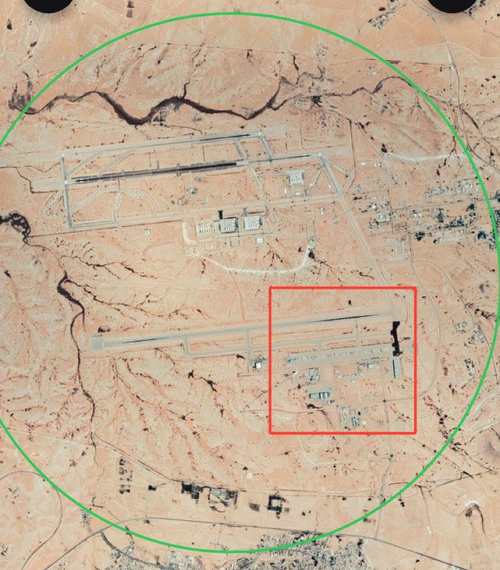
It does not show whole airbase, question is how rest looks and yet for satellite images of other airbase that was hit.
Another question of resolution as 30cm is limit for commercial satellite imagery and American government satellites can do 10cm per pixel/dot. Plausible some damage will not show up when of very small size such as 1cm or less, though such can be very destructive if for example electronic components are hit. For commercial satellite imagery it may not even show small craters from cluster munitions.
For all we know some of those planes could be riddled with fragments.
An interesting read about Iran military forces.

The reality is that each branch of Iran military has its own supporter among the mullahs: the usual funding vs political backers - turf war.
The winners
- paramilitary forces inside and outside Iran
- missiles
- the nuclear program
The losers
-the air force
-the navy
And I thought Congress arm-twisting NASA and ramming SLS into their lunar program for aerospace jobs, was bad...

The reality is that each branch of Iran military has its own supporter among the mullahs: the usual funding vs political backers - turf war.
The winners
- paramilitary forces inside and outside Iran
- missiles
- the nuclear program
The losers
-the air force
-the navy
However, this does not mean that Khamenei is ruling the country as an all-mighty autocrat. His power depends on support from dozens of rival ‘interest groups’, most of which are a part of or at least associated with the Islamic Revolutionary Guards Corps (IRGC, also ‘Pasdaran’). Confronted with the rising power of the cliques (‘cliques’ or even ‘gangs’ would be a better descriptions, because most of these are endemically corrupt, too), Khamenei sought a solution in letting the various of them take over different segments of the Iranian economy. And so, one of cliques established itself in control over the banks and insurances, another over the judiciary, yet another over the construction industry, then several over the real estate sector — and another one in control of the defence sector. For example, the gang to which the former President of Iran, Ahmadinejad, belonged, used to control banks and insurances… until its members fell in disgrace and were then (conveniently) prosecuted for corruption…
Point is: whenever there is some major decision to make in Tehran, each of these cliques is doing its utmost to have its fingers in the game, and each is pulling in own direction. If nothing else works, it sends ‘own’ units of the IRGC to ‘sort out the problem’: and, because it’s ‘acting in the name of the God’, the IRGC is above all the laws. It’s meanwhile powerful enough to remove Khamenei ‘in a matter of minutes’, if necessary.
Unsurprising result is a completely dysfunctional chain of command and totally unworkable decision-making processes. Officially, Iran is ruled by an official government and parliament, but the final say depends on agreements between different of cliques. Even the ‘Supreme Leader’ has to bow to their wishes.
And I thought Congress arm-twisting NASA and ramming SLS into their lunar program for aerospace jobs, was bad...
Last edited:
- Joined
- 2 January 2006
- Messages
- 3,816
- Reaction score
- 5,014
View attachment 742796
It does not show whole airbase, question is how rest looks and yet for satellite images of other airbase that was hit.
Another question of resolution as 30cm is limit for commercial satellite imagery and American government satellites can do 10cm per pixel/dot. Plausible some damage will not show up when of very small size such as 1cm or less, though such can be very destructive if for example electronic components are hit. For commercial satellite imagery it may not even show small craters from cluster munitions.
For all we know some of those planes could be riddled with fragments.
This is what I found so far ...

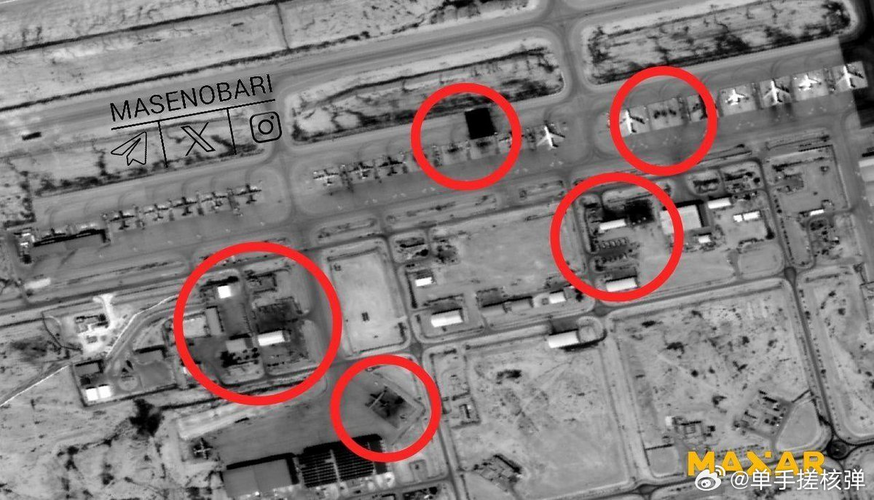
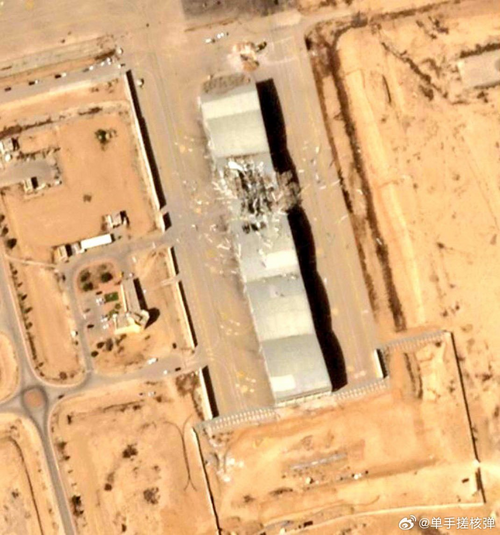
- Joined
- 3 June 2011
- Messages
- 18,308
- Reaction score
- 12,133
This is what I found so far ...
View attachment 742811
View attachment 742812
View attachment 742813
Any possibility on finding the original source of those photos? Some of them looks suspicious
Seven 2000lb bunker busters.
For long range strike missions, I imagine they would carry 2-4 bombs along with 3 drop tanks.
WatcherZero
ACCESS: Top Secret
- Joined
- 22 May 2023
- Messages
- 824
- Reaction score
- 1,917
View: https://x.com/dex_eve/status/1841986067458666640
More than expected got through at Nevatim, still no break in clouds at Tel Nof for damage assessment, looks like the only impact on Gilot was the one 400m from Mossad HQ.
More than expected got through at Nevatim, still no break in clouds at Tel Nof for damage assessment, looks like the only impact on Gilot was the one 400m from Mossad HQ.
Last edited:
Iran's leadership really, REALLY wants the Israeli airforce to repay their favour with a vengeance.
- Joined
- 6 August 2007
- Messages
- 3,874
- Reaction score
- 5,868
Another question of resolution as 30cm is limit for commercial satellite imagery and American government satellites can do 10cm per pixel/dot. Plausible some damage will not show up when of very small size such as 1cm or less, though such can be very destructive if for example electronic components are hit. For commercial satellite imagery it may not even show small craters from cluster munitions.
For all we know some of those planes could be riddled with fragments.

Scott Kenny
ACCESS: USAP
- Joined
- 15 May 2023
- Messages
- 11,448
- Reaction score
- 13,963
If a plane was riddled with fragments, you can also bet it burned. Which would leave a nice scorch mark on the tarmac, if nothing else.It does not show whole airbase, question is how rest looks and yet for satellite images of other airbase that was hit.
Another question of resolution as 30cm is limit for commercial satellite imagery and American government satellites can do 10cm per pixel/dot. Plausible some damage will not show up when of very small size such as 1cm or less, though such can be very destructive if for example electronic components are hit. For commercial satellite imagery it may not even show small craters from cluster munitions.
For all we know some of those planes could be riddled with fragments.
During the early hours of Saturday 26th of October, Israel Air force stroke back all across Iran for hours targeting missiles installations and IADS pre-dawn:
https://apnews.com/article/israel-p...s-10-25-2024-0920f63542d158ad5999c481e421da00
I am amazed by the strikes duration suggesting, either, a continued presence of supporting a/c and stream of attacking fighters taking off from Israel or a multiple shuttle flights strategy with strike package accomplishing multiple rotations in the process.
Edit:
Later released details would mention 3 waves of attacking aircrafts.
https://apnews.com/article/israel-p...s-10-25-2024-0920f63542d158ad5999c481e421da00
I am amazed by the strikes duration suggesting, either, a continued presence of supporting a/c and stream of attacking fighters taking off from Israel or a multiple shuttle flights strategy with strike package accomplishing multiple rotations in the process.
Edit:
Later released details would mention 3 waves of attacking aircrafts.
Last edited:
Tensions around a possible 3rd round:
- Joined
- 13 June 2007
- Messages
- 2,172
- Reaction score
- 3,077
And how much of the impact points are missile debris (from intercepted missiles) vs. whole missile getting thru? The size of the craters and hangar damage seem to me to be rather light for a warhead that gets thru. Thinking back to bunker busting in earlier Gulf War images.View: https://x.com/dex_eve/status/1841986067458666640
More than expected got through at Nevatim, still no break in clouds at Tel Nof for damage assessment, looks like the only impact on Gilot was the one 400m from Mossad HQ.
Enjoy the Day! Mark
Silver Star awarded to both F-15E Pilot and WSO for their actions over Jordan coordinating fighter defense and shooting down Iran launched drones:


 abcnews.go.com
abcnews.go.com
More extensive details of their actions and the Squadron achievements that night here (as linked by @Forest Green ):

 www.twz.com
www.twz.com

Capt. Lacie "Sonic" Hester, an F-15E instructor weapons systems officer, is the first Air Force woman to receive the Silver Star and only the 10th female service member ever to receive the award. Also receiving the Silver Star on Tuesday was her pilot, Maj. Benjamin "Irish" Coffey, for his role in coordinating the shootdowns from their two-seat fighter and then using all of their missiles and their fighter's Gatling guns to bring down some of the drones.
The actions by the U.S. Air Force units involved in the shootdown of about 80 Iranian drones have been described as the largest air-to-air enemy engagement by the United States in over 50 years.

1st female airman awarded Silver Star for shootdown of Iranian drones
The Air Force's first female airman received the Silver Star for her role in shooting down dozens of Iranian drones headed to Israel.
More extensive details of their actions and the Squadron achievements that night here (as linked by @Forest Green ):

F-15E Pilot Recounts Having To Switch To Guns After Missiles Ran Dry During Iranian Drone Barrage
The F-15E crew's story is one of many that night, with the type swatting down more than 70 Iranian drones in a matter of hours.
Last edited:
More details on the event here:
- interesting to learn that the ANG F-16 were among the first to engage the onslaught of drones
- Intersting to see how a kill zone was put in place for both the slow and low UAV and the fast and high Ballistic missiles with the inherent hazard of missile debrits raining down on the interceptors
- Include in the link below is the full list of decorated aviators

 www.airandspaceforces.com
www.airandspaceforces.com
- interesting to learn that the ANG F-16 were among the first to engage the onslaught of drones
- Intersting to see how a kill zone was put in place for both the slow and low UAV and the fast and high Ballistic missiles with the inherent hazard of missile debrits raining down on the interceptors
- Include in the link below is the full list of decorated aviators

Silver Star Airpower: Inside an F-15 Mission to Block an Attack on Israel
Airmen from the 494th Fighter Squadron were honored with the Silver Star and more for their actions protecting Israel from an Iranian attack.
Read more here in this 3 parts story:

 www.airandspaceforces.com
www.airandspaceforces.com

 www.airandspaceforces.com
www.airandspaceforces.com

 www.airandspaceforces.com
www.airandspaceforces.com

Silver Star Airpower: Inside an F-15 Mission to Block an Attack on Israel
Airmen from the 494th Fighter Squadron were honored with the Silver Star and more for their actions protecting Israel from an Iranian attack.

How USAF Fighters Kept Going Amid Chaos to Defend Israel
U.S. Air Force Airmen stationed in the Middle East launched fighters while facing imminent danger to defend Israel from Iran on April 13.

Airmen Heed Lessons from Their Air Victory over Iran
Airmen look back with pride and took lessons from April 13, when they took down scores of drones launched by Iran against Israel.
- Joined
- 13 June 2007
- Messages
- 2,172
- Reaction score
- 3,077
Good reads. Curious though - would have thought the V-1 attacks on Great Britain were actually larger - nearly 10,000 were launched in a period from June 1944 to March 1945. Nitpicking maybe, just want it set straight....Read more here in this 3 parts story:

Silver Star Airpower: Inside an F-15 Mission to Block an Attack on Israel
Airmen from the 494th Fighter Squadron were honored with the Silver Star and more for their actions protecting Israel from an Iranian attack.www.airandspaceforces.com

How USAF Fighters Kept Going Amid Chaos to Defend Israel
U.S. Air Force Airmen stationed in the Middle East launched fighters while facing imminent danger to defend Israel from Iran on April 13.www.airandspaceforces.com

Airmen Heed Lessons from Their Air Victory over Iran
Airmen look back with pride and took lessons from April 13, when they took down scores of drones launched by Iran against Israel.www.airandspaceforces.com
Thanks - Mark
@Mark Nankivil : Totally well funded remark. I think in this thread we used terms like the largest strike only for the IRBM launch total 
Regarding Space Guardians actions that night, follow this link to the US Space Force thread:

